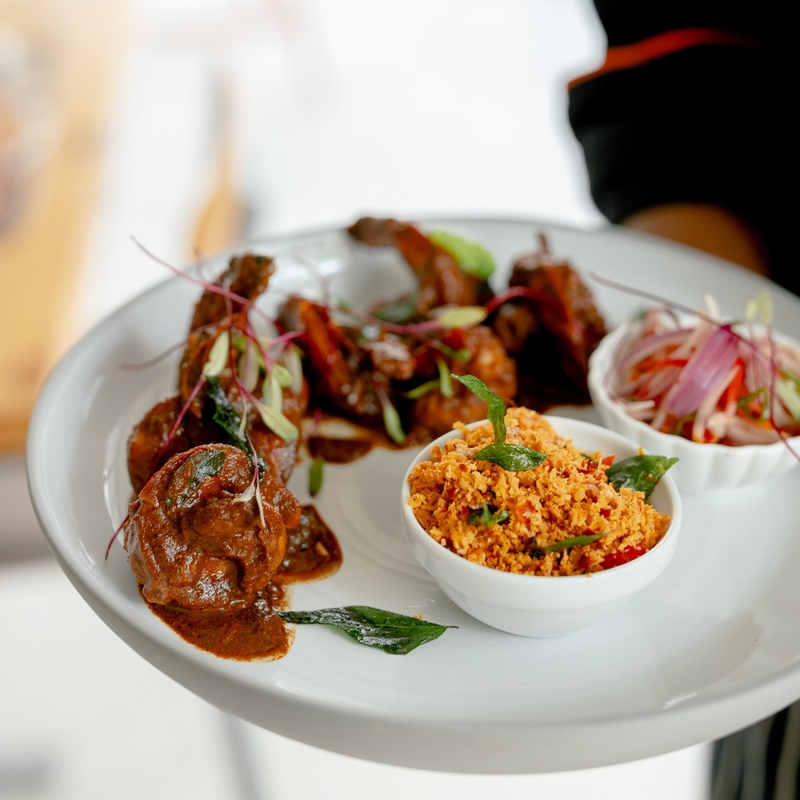CULTURES IN CUISINES
The Sri Lankan Cuisine

Art, by definition, is one that commands and insists on emotion; it demands the awakening of an individual’s expression, of creation. Food and the culinary, claim such passion in its craft and consumption. From intriguing shapes and forms, vibrant hues and creative placement, one is stimulated by the culmination of it that is seeped in the culinary. For instance, there is often no hesitancy or difficulty distinguishing the potent orange hue of a coconut relish or the bright green leaves that occupy a dish of rice and curry, as part of the Sri Lankan cuisine. And in distinguishing these distinctions, there is no lack of comprehension that each dish is a derivation of a home memory to the native; by its colour and vibrancy, dishes of thrill and intrigue to the new. In interpreting these aspects, each poignantly enhanced by its performative creation and evocative layering, we perceive the nuances of artistry involved in the culinary. Thus, here, we attempt to explore the creatively induced characteristics of the Sri Lankan cuisine, and the intricacies by which it is designed, from contemplation of form to consideration of colour, its regional and geographic influences and cultural inspirations.
Indisputably, the pear-shaped island of Sri Lanka is rich in culture and ethnicity. Moreover, the island’s opulent landscape is lush in fruit, its shores awash with tropical foods and meat, the nation personified for its authentic seafood cuisines or vibrantly coloured assorted dishes. From the Jaffna Peninsula’s popular Prawn curry to the traditional Kandyan sour fish curry, spread across the island are boldly intriguing characteristics of the culinary arts; inspired by the island’s region and geography, and some derived from the nation’s colonial influences. In essence, Sri Lanka is a multicultural space, brimming with diverse identities and sundry traditions, each reflected heavily in its cuisine and seeped profoundly and poignantly in the creation of these cuisines. We explored, back on ARTRA Magazine E57, with CEO of ISSO, the diverse nuances of the Sri Lankan cuisine from its Northern Plains and how each aspect of the dish is intricately woven into the products of the landscape. “The prawn is one of the main constituents of the Sri Lankan cuisine that is largely enjoyed; from the famous ISSO wade to variations of prawn curries originated from different parts of the country to the popular butter fried prawns. Culinary is the art of preparing food, cooking and presenting it. I had that privilege to work with passionate chefs during my career and learned from them, the attention to detail that goes into serving a meal,” explained Apinash Sivagumaaran.
Subsequently, the diverse and varied nature of the Sri Lankan cuisine has been gaining much traction in the international arena. Most recently, eleven year-old Georgia Eris took home the trophy for Junior MasterChef Australia 2020, her final plates being a variety of an authentic Sri Lankan cuisine - Saffron Rice, Pork Curry, Eggplant Curry, Cashew Curry, Cucumber Raita and Papadam. She followed her main course with a desert dubbed the ‘Tropical Mess’ in reflection of the Sri Lanka’s identity as an inherently tropical island, with toasted coconut ice cream, brown bread crumb, Davidson plum pearls, Davidson plum meringues and a lemongrass granita. Thus, the design by which the cuisine was prepared, innovatively aligned to project the cuisine of her native roots that received much recognition and applause. Preceding Georgia’s celebrated victory, it was Kumar Pereira who participated in the third season of MasterChef Australia who was known to have given the Sri Lankan cuisine wide international recognition. From the nation’s coconut relish to dhal, a staple dish to the natives, the identity of the Sri Lankan culinary components are those that have been influenced by culture and its colonial influences. Through geo-politics and sea trade, the elements of Afro-Arabic, Central Asian, European, South-east Asian, and Oriental food cultures seep into the national cuisine and take on its own personality.

The island is widely popular for its tea plantations, a methodology and practice left behind from the British invasion to Sri Lanka. Ceylon Tea now becomes a staple to the cuisine; its dark, rich, brown tea blend has been distributed across the world and have been known to possess a stronger, wealthier taste and aroma. It is an intrinsic component of the Sri Lankan cuisine, the culinary art of making a beverage of tea inherent to the Ceylon culture. But the cuisine’s traditional elements do not limit themselves to a single cup of tea – a rich, vibrant green fusion of boiled rice, scraped fresh coconuts and its milk, added to blended and boiled leafy greens like gotu kola, moringa, and curry leaves are a staple in the daily life of an individual. Bon Apetit Mag recently interviewed Sri Lankan born Sajani Amarasiri for her version of the Kola Kanda.
Essentially, the characteristics of the Sri Lankan cuisine are a wealth of taste, colour, shapes and forms; from circular fried papadam to lamprais meal of rice and curry served on a banana leaf, the distinct aroma of tea leaves in the early morning or the end of a hard day’s work, from the thick white grains of milk rice that adorn the tables of breakfast in the morning or the devilled and spiced fundamental side dishes of fish or prawn. In attempting to observe and explore the performative elements that create the native cuisine and the evocative nuances it elicits, we find the Culinary Art of the Sri Lankan food interwoven into a sundry of cultures and ethnicities, influenced by its geography and landscape, the island and its innovations in the culinary are abundantly rich, vibrant and deeply aromatic.

